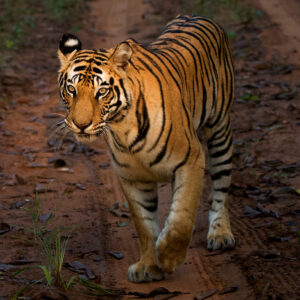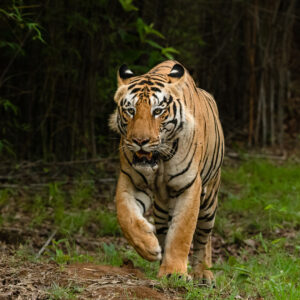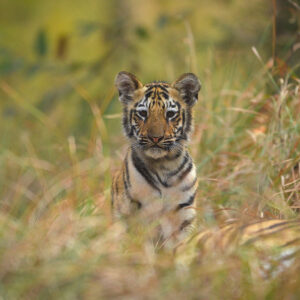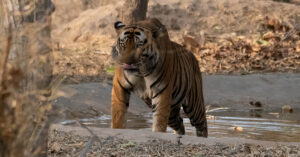Bandhavgarh National Park
Bandhavgarh National Park, located in the Umaria district of Madhya Pradesh, India, is a mesmerizing sanctuary known for its abundant wildlife and breathtaking landscapes. In this blog, we’ll explore Bandhavgarh’s attractions, where the majestic Bengal tiger rules supreme and other breathtaking animals wander free.
The Historical and Geographical Significance of Land of Tigers Bandhavgarh
Bandhavgarh National Park has a fascinating history, with its name translating to “Brother’s Fort” about the ancient fort atop Bandhavgarh Hill. Once a hunting ground for maharajas, the region was later declared a national park in 1968, preserving its natural wonders for generations.
Spanning across an expansive 105 square kilometers, Bandhavgarh boasts a diverse landscape comprising dense forests, rocky hills, and open meadows. The park is divided into three zones: Tala, Magdi, and Bamera, each offering distinct charm and opportunities for wildlife encounters.
The Magnificent Bengal Tigers of Bandhavgarh
Land of Tigers One of the top locations in India for tiger sightings is Bandhavgarh, which is well known for its healthy Bengal tiger population. The park’s successful conservation efforts have resulted in an estimated 90 tigers residing within its boundaries. These majestic creatures, with their vibrant orange and black stripes blending harmoniously with the lush surroundings, embody the regal beauty of the wild. A genuinely breathtaking experience, seeing a tiger in its native habitat provides tourists with lasting impressions.
Diverse Wildlife Species in Bandhavgarh
While the tigers steal the spotlight, Bandhavgarh is also home to a remarkable array of wildlife. Leopards, sloth bears, wild boars, Indian bison (gaur), spotted deer, sambar deer, and langurs are among the diverse species that inhabit the park. The avian population is equally captivating, with over 250 bird species, including endangered vultures, gracing the park with their presence. Exploring the park’s trails and safari routes offers ample opportunities to witness these remarkable creatures in their natural habitat, creating lasting memories of the park’s thriving ecosystem.
Flora and fauna of Bandhavgarh
A wide variety of flora and fauna characterizes Bandhavgarh’s vibrant ecosystem. Sal and Bamboo forests dominate the landscape, interspersed with picturesque meadows and serene water bodies. This diverse habitat provides a haven for countless plant and tree species, creating a lush and picturesque environment. Furthermore, Bandhavgarh is known for its medicinal plants and herbs, some of which hold cultural and historical significance. Botany enthusiasts will be delighted by the park’s diverse plant life, which adds to the overall allure of this enchanting land.
Experiencing Bandhavgarh: Safari and Other Activities
To fully Engage deeply oneself in the enchantment of Bandhavgarh, Beginning on a safari is an absolute must. The park allows visitors to explore its expansive landscapes with the help of trained and experienced guides by offering jeep safaris and elephant safaris. These safaris take visitors deep into the park’s heart, increasing the chances of encountering the elusive tigers and other fascinating wildlife species.
Apart from safaris, Bandhavgarh offers a range of activities for nature enthusiasts. Nature walks, bird watching, and photography tours allow visitors to forge a deeper connection with the park’s natural beauty. Furthermore, the park’s rich historical background offers the chance to explore the ancient fort and nearby archaeological sites, adding a cultural dimension to the wildlife experience.
Are you ready for an exciting adventure in the wild? Nature’s Sprouts is your go-to destination for unforgettable jungle safari tours!
Our website – naturessprouts.com
Our Safari Spot: Bandhavgarh National Park
Why Choose Us:
- Expert Guides: Our experienced guides will make your safari memorable.
- Comfy Stays: Enjoy comfortable accommodations after your adventures.
- Custom Packages: Tailored experiences to match your interests.
- Safety First: Your safety is our priority.
Contact Us Now:
Ready to book? Call us at 7719806444 or 9755725345.
Visit Us:
Address: Plot No. 8, Near Bhende Layout, Pannase Layout, Nagpur – 440022.
Email Us:
Have questions? Email us at info@naturessprouts.com.
Nature’s Sprouts invites you to dive into the wild with us. Book your adventure today!
Conservation and Future Challenges of Land of Tigers
Bandhavgarh’s success in tiger conservation is a testament to the collaborative efforts of government authorities, local communities, and wildlife enthusiasts. It is home to a developing tiger population because of severe anti-poaching measures, habitat restoration work, and community-based conservation programs. Additional measures are required to secure the long-term survival of these famous animals and their habitat.
As tourism in Bandhavgarh continues to grow, it is vital to balance conservation and sustainable tourism practices. Responsible tourism, with minimal ecological impact, and educational initiatives focusing on wildlife conservation are essential for preserving the biodiversity of Bandhavgarh for future generations.
Bandhavgarh National Park offers an enchanting experience for nature lovers and wildlife enthusiasts. It gives attention to the incredible beauty of nature, with its breathtaking vistas and a wide variety of creatures.
Frequently Asked Questions
Q: Where is Bandhavgarh located?
Bandhavgarh is located in the Umaria district of Madhya Pradesh, India.
Q: What is Bandhavgarh known for?
Bandhavgarh is renowned for its thriving population of tigers. It is considered one of the best places in India to spot these majestic beasts in their natural habitat. Apart from tigers, Bandhavgarh is also home to a diverse range of wildlife, including leopards, deer, langurs, and numerous bird species.
Q: How can I reach Bandhavgarh?
The nearest airport to Bandhavgarh is Jabalpur Airport, approximately 200 kilometer away. You can hire a taxi or take a bus from the airport to Bandhavgarh. The nearest railway station is Umaria, which is well-connected to major cities in India. From there, you can travel to Bandhavgarh by taxi or bus.
Q: When is the best time to visit Bandhavgarh?
The best time to visit Bandhavgarh is during the winter, from November to February, when the weather is pleasant and ideal for wildlife safaris. The park remains closed during the monsoon season from July to October.
Q: Are safaris available in Bandhavgarh?
Bandhavgarh National Park is Land of Tigers offers jeep and elephant safaris for visitors to explore the park and spot wildlife. These safaris are conducted by trained guides and experienced drivers in navigating the park’s terrain and ensuring a safe and enjoyable experience.
Bandhavgarh offers a remarkable and enchanting experience for nature enthusiasts and wildlife lovers. With its thriving tiger population and diverse range of wildlife species, this destination is a paradise for wildlife enthusiasts. From thrilling safaris to breathtaking landscapes, Bandhavgarh provides a unique opportunity to witness the raw beauty of nature.
What to Do in Bandhavgarh National Park is Land of Tigers for an Awesome Experience
If you’re planning a visit to Bandhavgarh National Park in India is Land of Tigers, you’re in for a real treat. This place is packed with exciting things to do and incredible natural beauty. Let’s explore some of the top activities you can enjoy in this amazing park.
1. Go on a Safari: Meet the Wild Side
Hop on a safari adventure! Whether it’s a jeep or an elephant ride, you’ll get up close and personal with animals like Bengal tigers, leopards, deer, and lots of beautiful birds.
2. Explore Bandhavgarh Fort: Step Back in Time
Discover the Very old Bandhavgarh Fort, which is over 2000 years old. You’ll not only see history but also get breathtaking views of the park.
3. Bird Watching: For the Bird Lovers
Bird watchers, this place is paradise. There are over 250 bird species to spot, so don’t forget your binoculars!
4. Take a Nature Walk: Find Inner Peace
Enjoy a peaceful walk in the park with an expert guide. You’ll see different plants and animals and feel totally relaxed.
5. Photography Fun: Capture the Moment
Photographers, get ready for some amazing shots of landscapes and wildlife. Bandhavgarh won’t disappoint.
6. Learn at Wildlife Centers: Get Educated
Visit the wildlife interpretation centers to learn about the park’s conservation efforts and the creatures that call it home.
7. Visit Villages: Meet the Locals
Get a taste of local culture by visiting nearby villages. You might even get to try some traditional activities.
8. Yoga and Meditation: Inner Harmony
Find your inner peace surrounded by nature. Bandhavgarh’s tranquility is perfect for yoga and meditation.
9. Stay in Jungle Resorts: Comfort in the Wild
Make your stay unforgettable by booking a jungle resort. Enjoy modern amenities while being close to nature.
How to Reach Bandhavgarh National Park is the Land of Tigers
By Air
The nearest airport to Bandhavgarh National Park is Jabalpur Airport, which is approximately 190 kilometers away. You can book a domestic flight to Jabalpur from major Indian cities. From the airport, you can hire a taxi or take a bus to reach the park.
By Train
The closest railway station to Bandhavgarh is Umaria Railway Station, located around 37 kilometers away. You can take a train to Umaria from various cities in India. Once you reach Umaria, you can hire a taxi or take a local bus to reach the park.
By Road
Bandhavgarh National Park is well-connected by road to major cities in Madhya Pradesh and nearby states. You can drive to the park or hire a taxi from nearby towns like Umaria, Katni, or Jabalpur. National Highway 7 and State Highway 10 provide good road access to the park.
Best Time to Visit Bandhavgarh National Park is Land of Tigers
October to June is the ideal time to visit Bandhavgarh National Park is Land of Tigers. During this period:
- October to March (Winter): The weather is pleasant and cool, making it great for wildlife sightings. Animals are more active, and the vegetation is less dense, making them easier to spot.
- April to June (Summer): This is when the park’s water sources start to dry up, making it easier to spot animals gathering around them. It’s also the best time for birdwatching.








